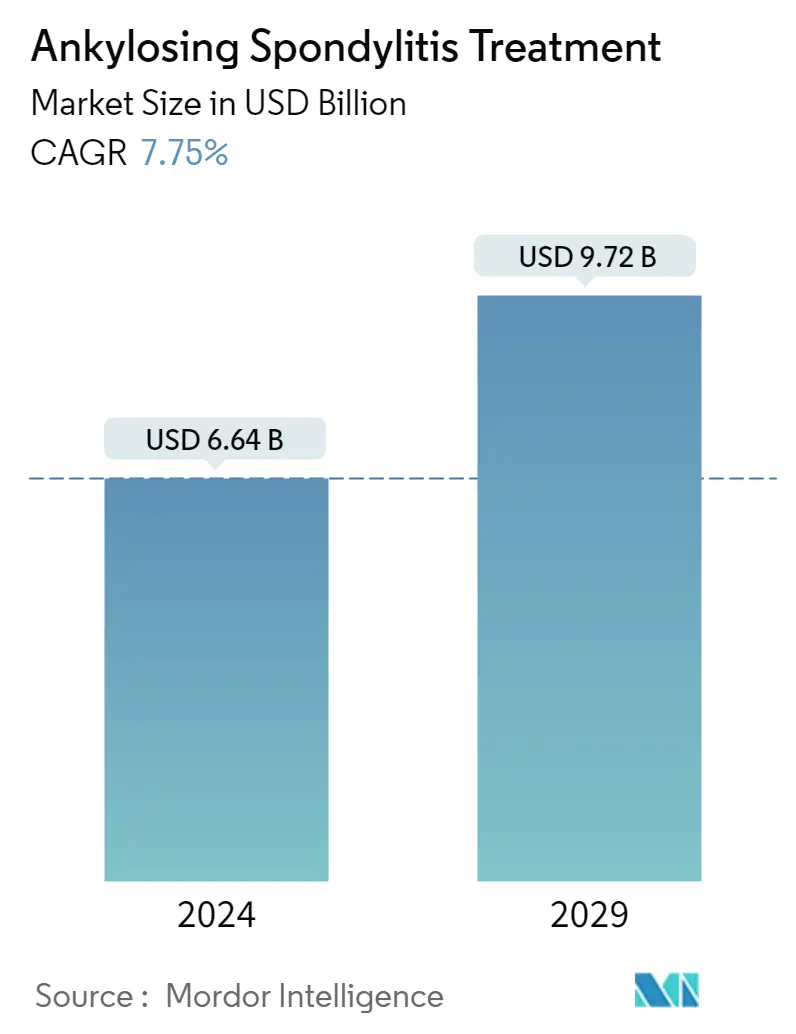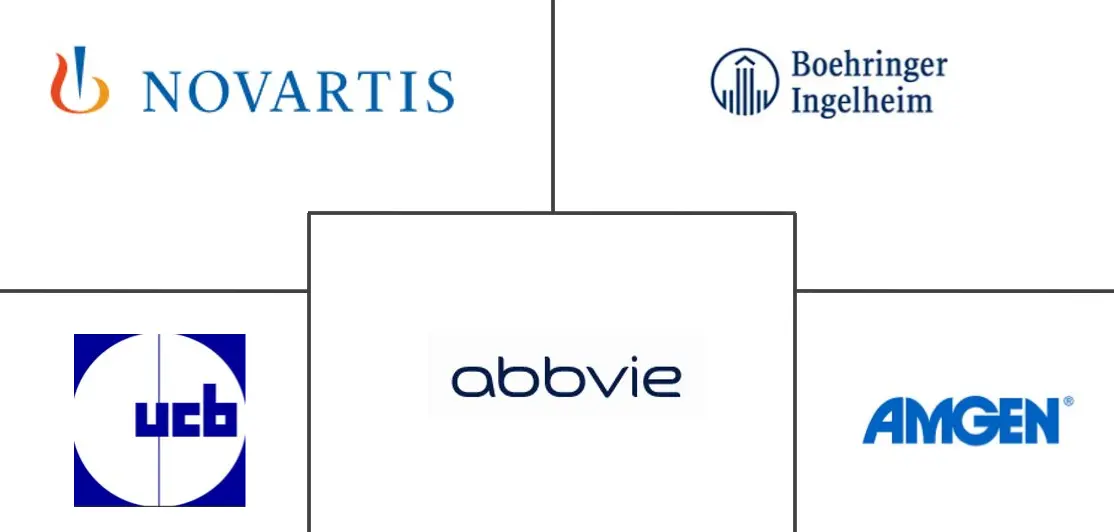Market Size of Ankylosing Spondylitis Treatment Industry

| Study Period | 2019 - 2029 |
| Market Size (2024) | USD 6.64 Billion |
| Market Size (2029) | USD 9.72 Billion |
| CAGR (2024 - 2029) | 7.75 % |
| Fastest Growing Market | Asia-Pacific |
| Largest Market | North America |
| Market Concentration | Low |
Major Players
*Disclaimer: Major Players sorted in no particular order |
Ankylosing Spondylitis Treatment Market Analysis
The Ankylosing Spondylitis Treatment Market size is estimated at USD 6.64 billion in 2024, and is expected to reach USD 9.72 billion by 2029, growing at a CAGR of 7.75% during the forecast period (2024-2029).
- Ankylosing spondylitis (AS), a chronic inflammatory disease primarily impacting the spine and large joints, requires a comprehensive treatment approach to manage symptoms and slow disease progression. The multifaceted treatment strategies for ankylosing spondylitis focus on alleviating pain, reducing inflammation, maintaining mobility, and preventing complications. Key treatment modalities include medications, physical therapy, and, in severe cases, surgery. Understanding the efficacy of various ankylosing spondylitis treatment options is critical for optimizing patient outcomes.
Diverse Treatment Options for Ankylosing Spondylitis
- Medications: The ankylosing spondylitis treatment landscape includes nonsteroidal anti-inflammatory drugs (NSAIDs), TNF inhibitors, IL-17 inhibitors, and other biologics. NSAIDs, such as ibuprofen and naproxen, are often the first-line treatment, providing relief from pain and inflammation. TNF inhibitors and IL-17 inhibitors are crucial for patients unresponsive to NSAIDs, offering targeted therapy to reduce inflammation and prevent further joint damage.
- Physical Therapy: Physical therapy is vital in maintaining spinal mobility and reducing pain, ensuring that patients retain function and quality of life. Regular exercise for ankylosing spondylitis, guided by physical therapists, helps in strengthening muscles, improving posture, and enhancing flexibility, which is essential for managing the disease.
- Surgical Interventions: Surgery for ankylosing spondylitis may be considered for patients with severe deformities or refractory symptoms that do not respond to conventional therapies. Surgical options include spinal fusion or hip replacement to address severe pain or deformity.
Escalating Disease Prevalence and Advancements in Reimbursement Models
- Increasing Prevalence: The global burden of ankylosing spondylitis is rising, particularly in regions with a high prevalence of autoimmune diseases. This trend has increased the demand for effective ankylosing spondylitis treatment options. As the understanding of the disease pathophysiology improves, more targeted therapies are developed, enhancing the overall management of ankylosing spondylitis.
- Reimbursement Models: Advancements in reimbursement models have significantly impacted patient access to ankylosing spondylitis medication, especially expensive biologics. In regions with robust healthcare systems, such as North America and Europe, reimbursement policies have evolved to facilitate patient access to high-cost treatments. Government subsidies and expanded insurance coverage have also played a critical role in increasing the adoption of advanced therapies like biologics for ankylosing spondylitis.
High Costs Pose Significant Challenges for Patients and Healthcare Systems
- Economic Barriers: Despite the therapeutic advancements, the high cost of biologic therapies remains a significant barrier to widespread adoption. Treatments like TNF inhibitors and IL-17 inhibitors are often priced at a premium, making them inaccessible to many patients, particularly in low- and middle-income countries. This financial burden can lead to decreased adherence to treatment regimens, resulting in suboptimal patient outcomes.
- Healthcare System Challenges: The high cost of ankylosing spondylitis treatment poses challenges for healthcare systems that must balance budget constraints with the need to provide comprehensive care. The cost-effectiveness of these treatments is under constant scrutiny, leading to varying levels of access based on the economic policies and healthcare infrastructure in place. This disparity highlights the need for developing more cost-effective treatment strategies that ensure equitable access to care.
Ankylosing Spondylitis Treatment Industry Segmentation
As per the scope of the report, ankylosing spondylitis (previously known as Bechterew's disease, Bechterew syndrome, Marie Strümpell disease) is a chronic inflammatory immune-mediated condition primarily affecting the sacroiliac joints and spine.
The ankylosing spondylitis treatment market is segmented by treatment types and geography. By treatment type, the market is segmented into medication, therapy, and surgery. The medication segment includes nonsteroidal anti-inflammatory drugs (NSAIDs), TNF inhibitors, IL-17 inhibitors, and others. By geography, the market is segmented into North America, Europe, Asia-Pacific, the Middle East and Africa, and South America. The market report also covers the estimated market sizes and trends for 17 different countries across major regions globally. The report offers the value (in USD) for the above segments.
| By Treatment Types | ||||||
| ||||||
| Therapy | ||||||
| Surgery |
| Geography | ||||||||
| ||||||||
| ||||||||
| ||||||||
| ||||||||
|
Ankylosing Spondylitis Treatment Market Size Summary
The ankylosing spondylitis treatment market is poised for significant growth over the forecast period, driven by an increasing prevalence of the disease and advancements in treatment options. The market has shown resilience in the aftermath of the COVID-19 pandemic, which initially disrupted clinical studies and supply chains. However, the adoption of telehealth services and the gradual recovery of market activities have contributed to a stable growth trajectory. The market is characterized by a surge in product approvals and launches, alongside rising reimbursements from both government and private sectors. These factors, coupled with heightened awareness and the development of effective therapies, are expected to propel the market forward.
North America is anticipated to maintain a substantial share of the market, supported by a high prevalence of ankylosing spondylitis and robust reimbursement frameworks. The region's growth is further bolstered by ongoing research and development efforts leading to new product approvals. The market landscape is moderately competitive, with key players like Novartis, Amgen, and AbbVie actively engaged in research and manufacturing of treatment drugs. Strategic initiatives, such as clinical trials and partnerships, are also contributing to market expansion. Despite the high cost of treatment posing a challenge, the overall outlook for the ankylosing spondylitis treatment market remains positive, with continued growth expected throughout the analysis period.
Ankylosing Spondylitis Treatment Market Size - Table of Contents
-
1. MARKET DYNAMICS
-
1.1 Market Overview
-
1.2 Market Drivers
-
1.2.1 Growing Burden of Target Diseases and Rising Reimbursements for the Treatment
-
1.2.2 Research and Development for Effective Treatment
-
-
1.3 Market Restraints
-
1.3.1 High Cost of Treatment
-
-
1.4 Porter's Five Force Analysis
-
1.4.1 Threat of New Entrants
-
1.4.2 Bargaining Power of Buyers/Consumers
-
1.4.3 Bargaining Power of Suppliers
-
1.4.4 Threat of Substitute Products
-
1.4.5 Intensity of Competitive Rivalry
-
-
-
2. MARKET SEGMENTATION (Market Size by Value - USD)
-
2.1 By Treatment Types
-
2.1.1 Medication
-
2.1.1.1 Nonsteroidal Anti-Inflammatory Drugs (NSAIDs)
-
2.1.1.2 TNF Inhibitors
-
2.1.1.3 IL-17 Inhibitors
-
2.1.1.4 Others
-
-
2.1.2 Therapy
-
2.1.3 Surgery
-
-
2.2 Geography
-
2.2.1 North America
-
2.2.1.1 United States
-
2.2.1.2 Canada
-
2.2.1.3 Mexico
-
-
2.2.2 Europe
-
2.2.2.1 Germany
-
2.2.2.2 United Kingdom
-
2.2.2.3 France
-
2.2.2.4 Italy
-
2.2.2.5 Spain
-
2.2.2.6 Rest of Europe
-
-
2.2.3 Asia-Pacific
-
2.2.3.1 China
-
2.2.3.2 Japan
-
2.2.3.3 India
-
2.2.3.4 Australia
-
2.2.3.5 South Korea
-
2.2.3.6 Rest of Asia-Pacific
-
-
2.2.4 Middle East and Africa
-
2.2.4.1 GCC
-
2.2.4.2 South Africa
-
2.2.4.3 Rest of Middle East and Africa
-
-
2.2.5 South America
-
2.2.5.1 Brazil
-
2.2.5.2 Argentina
-
2.2.5.3 Rest of South America
-
-
-
Ankylosing Spondylitis Treatment Market Size FAQs
How big is the Ankylosing Spondylitis Treatment Market?
The Ankylosing Spondylitis Treatment Market size is expected to reach USD 6.64 billion in 2024 and grow at a CAGR of 7.75% to reach USD 9.72 billion by 2029.
What is the current Ankylosing Spondylitis Treatment Market size?
In 2024, the Ankylosing Spondylitis Treatment Market size is expected to reach USD 6.64 billion.

